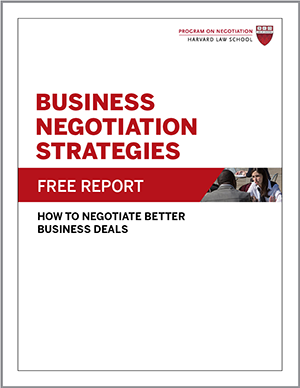
Apple isn’t used to making negotiation mistakes. The company has often found success by charging headfirst into unfamiliar industries, from book publishing to music to mobile phones, and disrupting its long-standing business models. In the early 2000s, for example, the company’s cofounder, Steve Jobs, pressured music labels to switch from selling $15 CDs to selling songs online for 99 cents each.
No surprise, then, that when the company decided to take Apple TV to the next level, it tried to sell media companies on new ways of doing business. But the company’s aggressive strategy led to a string of negotiation mistakes, as Shalini Ramachandran and Daisuke Wakabayashi reported in the Wall Street Journal in July 2016. The failed negotiation case study resonates to this day.
A Bigger Bite out of TV
For years, Apple referred to Apple TV—a small box that connects to TVs so that users can stream content from providers—as a “hobby,” according to Fortune.com. But when sales of the iPhone began to level off, the company became eager to beef up its TV business. In 2009, Apple tried to entice media companies to contribute channels to its service by offering above-average fees, but they balked when Apple would take only some of their channels.
In 2011, Apple tried to reach deals with cable companies Comcast and Time Warner Cable for joint TV services. But Apple asked for too high a payment from subscribers ($10 per month) and was reluctant to share details about its proposed interface, sources told the Journal.
Two years later, new meetings with Time Warner got off to a rocky start when Apple executive Eddy Cue reportedly showed up late at the cable company’s Manhattan offices dressed in jeans, a Hawaiian shirt, and tennis shoes. Apple’s aggressive demands at that meeting and others—such as that viewers should be allowed to skip ads when watching new shows—led TV channel owners to wonder whether “the Apple guys” had “any idea how this industry works,” one former Time Warner executive told the Journal.
One cable-industry executive summed up Cue’s strategy as simply saying, “We’re Apple.” Another told the Journal that the TV industry was comfortable saying no to Apple because it didn’t need a “white knight to come racing in” the way the music industry had.
More Unfruitful Talks
In early 2015, Cue began pitching media companies such as Disney, Fox, and CBS on the idea of putting together a “skinny bundle” of about 25 channels that would include their hit shows.
Cue reportedly made unheard-of demands of Disney, including freezing the monthly rate-per-viewer Apple would pay to license Disney channels for several years. Disney and other companies knew such a concession would set a bad precedent. Once again, talks broke down.
Following these negotiation mistakes, Apple was unable to announce a streaming TV service when it launched its newest Apple TV set-top box in September 2015.
Apple Tries to Go Hollywood
Apple then turned to revamping its TV device to allow apps from networks and to broaden its original programming. The company started meeting with Hollywood executives about creating new shows. The executives reportedly were “bemused” that Apple sent a little-known producer to negotiations that typically would involve high-level players from all sides, according to the Journal.
Eventually, Apple put its Apple TV set-top box on the back burner and invested heavily in Apple TV+, a subscription streaming service for original content, and Apple TV Channels, an app that manages users’ streaming services. According to one estimate, Apple TV+ was earning about $76 million in revenues by late 2020—but the company likely was still spending much more. Apple’s early negotiation mistakes contributed to it being slow out of the gate relative to competitors.
Lessons Learned from Apple’s Negotiation Mistakes
Apple made several common negotiation mistakes that could have been avoided by following these negotiation skills and strategies:
- Study industry practices. When proposing an alternative model in an unfamiliar industry, you need to be able to compellingly explain what advantages it would offer your counterpart over the prevailing one.
- Fulfill cultural norms. Norms surrounding meetings—such as what to wear, who should attend, and whether punctuality is important (hint: It almost always is)—can vary across industries and cultures. When meeting someone for the first time, research norms and expectations so you can make a great initial impression.
- Analyze power levels. If an aggressive approach worked for you in one negotiation, don’t assume that a hard-bargaining style will automatically transfer to negotiations with other organizations. Apple’s disruptive mentality was effective in industries that were desperate to innovate. The TV industry, by contrast, had less need to do business with Apple. Thus, it gained bargaining power from its ability to walk away. A mutual gains approach to negotiation would have been more effective for Apple.
What negotiation mistakes have you observed and learned from lately?





